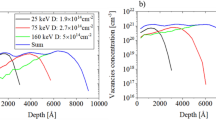Abstract
We have studied the annealing properties of AsGa-related defects in layers of GaAs grown at low substrate temperatures (300°C) by molecular beam epitaxy (low temperature[LTx]-GaAs). The concentration of neutral AsGa-related native defects, estimated by infrared absorption measurements, ranges from 2×1019 to 1×1020 cm−3. Slow positron annihilation results indicate an excess concentration of Ga vacancies in LT layers over bulk grown crystals. A sharp annealing stage at 450°C marks a rapid decrease in the AsGa defect concentration. We propose that the defect removal mechanism is the diffusion of AsGa to arsenic precipitates, which is enhanced by the presence of excess VGa. The supersaturated concentration of VGa must also decrease. Hence, the diffusivity of the AsGa defects is time dependent. Analysis of isothermal annealing kinetics gives an enthalpy of migration of 2.0±0.3 eV for the photoquenchable AsGa defects, 1.5±0.3 eV for the VGa, and 1.1±0.3 eV for the nonphotoquenchable defects. The difference in activation enthalpy represents difference energy between an As atom and Ga atom swapping sites with a VGa.
Similar content being viewed by others
References
M. Kaminska, E.R. Weber, Z. Liliental-Weber, R. Leon and Z. Rek,J. Vac. Sci. Technol. B7, 710 (1989).
M. Kaminska, Z. Liliental-Weber, E.R. Weber, T. George, J.B. Kortright, F.W. Smith, B.-Y. Tsaur and A.R. Calawa,Appl Phys. Lett. 54, 1881 (1989).
M.R. Melloch, N. Otsuka, J.M. Woodall and A.C. Warren,Appl. Phys. Lett. 57, 1531 (1990).
E.R. Weber and J. Schneider,Physica 116B, 398 (1983).
R. Coates and E.W.J. Mitchell,Adv. in Phys. 24, 593 (1975).
D.E. Bliss, W. Walukiewicz, J.W. Ager III, E.E. Haller and K.T. Chan,J. Appl. Phys. 71, 1699 (1992).
M.O. Manasreh, D.C. Look, K.R. Evans, C.E. Stutz,Phys. Rev B 41, 10272 (1990).
G.M. Martin,Appl. Phys. Lett. 39, 747 (1981).
J.-L. Lee, A. Uedono and S. Tanigawa,J. Appl. Phys. 67, 6153 (1990).
F.S. Ham,J. Phys. Chem. Solids 6, 335 (1958).
M.v. Smoluchowski,Physik. Zeitschr. 17, 585 (1916).
J.W. Farmer and D.C. Look.Phys. Rev. B 21, 3389 (1980).
J.L. Rouviere, Y. Kim, J. Cunningham, J.A. Rentschler, A. Bourret and A. Ourmazd,Phys. Rev. Lett. 68, 2798 (1992).
Author information
Authors and Affiliations
Rights and permissions
About this article
Cite this article
Bliss, D.E., Walukiewicz, W. & Haller, E.E. Annealing of AsGa-related defects in LT-GaAs: The role of gallium vacancies. J. Electron. Mater. 22, 1401–1404 (1993). https://doi.org/10.1007/BF02649985
Received:
Issue Date:
DOI: https://doi.org/10.1007/BF02649985



